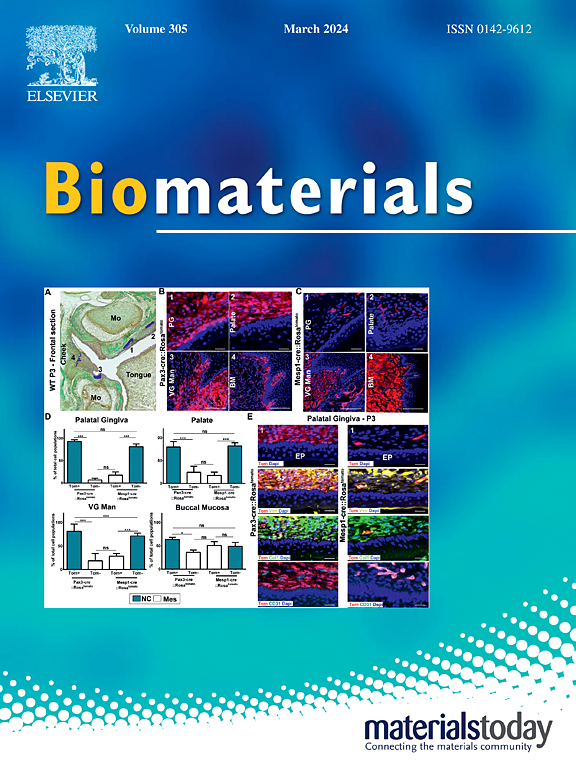Herbal micelles-loaded ROS-responsive hydrogel with immunomodulation and microenvironment reconstruction for diabetic wound healing
IF 12.9
1区 医学
Q1 ENGINEERING, BIOMEDICAL
引用次数: 0
Abstract
Persistent inflammation is a major cause of diabetic wounds that are difficult to heal. This is manifested in diabetic wounds with excessive reactive oxygen clusters (ROS), advanced glycation end products (AGE) and other inflammatory factors, and difficulty in polarizing macrophages toward inhibiting inflammation. Berberine is a natural plant molecule that inhibits inflammation; however, its low solubility limits its biological function through cytosis. In this study, we designed F127 micelles to encapsulate berberine with the aim of improving its solubility and bioavailability. Meanwhile, in order to achieve effective drug delivery at the wound site, we designed an injectable ferrocene-cyclodextrin self-assembled oxidation-reactive supramolecular hydrogel drug delivery system. Cellular experiments have shown that the hydrogel can reduce intracellular ROS and AGE production, attenuate cellular damage, promote macrophage polarization toward inhibition of inflammation, and reduce the secretion of inflammatory factors. In an animal model of diabetic mice, this hydrogel dressing reduces the level of inflammation in diabetic wounds, optimizes collagen deposition in diabetic wounds, and ultimately achieves high-quality diabetic wound healing. The work offers a straightforward and effective solution to the challenge of administering hydrophobic anti-inflammatory agents in the context of diabetic wound therapy.

具有免疫调节和微环境重建功能的草药胶束负载ros反应水凝胶用于糖尿病伤口愈合。
持续的炎症是糖尿病伤口难以愈合的主要原因。这表现在糖尿病创面活性氧团簇(ROS)过多、糖基化终末产物(AGE)晚期等炎症因子,以及巨噬细胞难以极化抑制炎症。小檗碱是一种天然的植物分子,可以抑制炎症;然而,它的低溶解度限制了它通过细胞作用的生物学功能。在本研究中,我们设计了F127胶束来包封小檗碱,目的是提高其溶解度和生物利用度。同时,为了实现伤口部位的有效给药,我们设计了一种可注射的二茂铁-环糊精自组装氧化反应超分子水凝胶给药系统。细胞实验表明,水凝胶可以减少细胞内ROS和AGE的产生,减轻细胞损伤,促进巨噬细胞向抑制炎症的方向极化,减少炎症因子的分泌。在糖尿病小鼠动物模型中,该水凝胶敷料降低了糖尿病创面的炎症水平,优化了糖尿病创面的胶原沉积,最终实现了高质量的糖尿病创面愈合。这项工作提供了一个直接和有效的解决方案,以管理疏水抗炎剂在糖尿病伤口治疗的背景下的挑战。
本文章由计算机程序翻译,如有差异,请以英文原文为准。
求助全文
约1分钟内获得全文
求助全文
来源期刊

Biomaterials
工程技术-材料科学:生物材料
CiteScore
26.00
自引率
2.90%
发文量
565
审稿时长
46 days
期刊介绍:
Biomaterials is an international journal covering the science and clinical application of biomaterials. A biomaterial is now defined as a substance that has been engineered to take a form which, alone or as part of a complex system, is used to direct, by control of interactions with components of living systems, the course of any therapeutic or diagnostic procedure. It is the aim of the journal to provide a peer-reviewed forum for the publication of original papers and authoritative review and opinion papers dealing with the most important issues facing the use of biomaterials in clinical practice. The scope of the journal covers the wide range of physical, biological and chemical sciences that underpin the design of biomaterials and the clinical disciplines in which they are used. These sciences include polymer synthesis and characterization, drug and gene vector design, the biology of the host response, immunology and toxicology and self assembly at the nanoscale. Clinical applications include the therapies of medical technology and regenerative medicine in all clinical disciplines, and diagnostic systems that reply on innovative contrast and sensing agents. The journal is relevant to areas such as cancer diagnosis and therapy, implantable devices, drug delivery systems, gene vectors, bionanotechnology and tissue engineering.
 求助内容:
求助内容: 应助结果提醒方式:
应助结果提醒方式:


